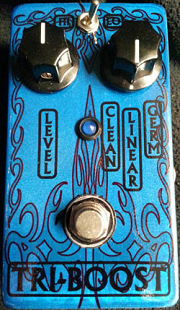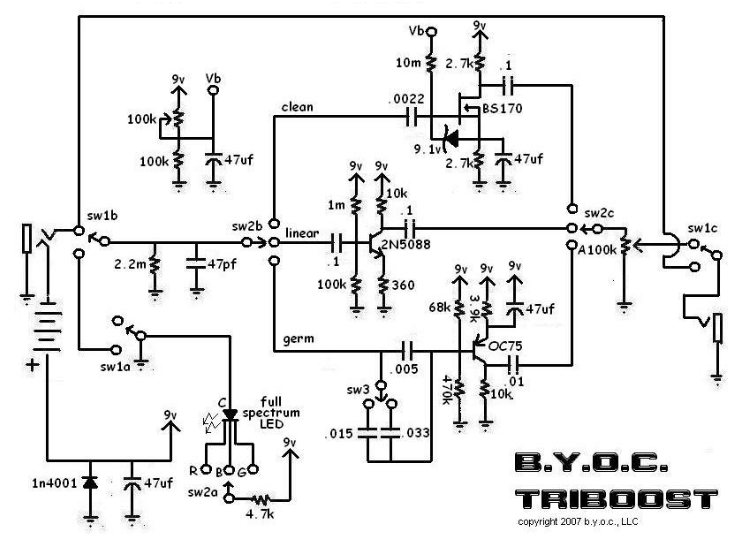Difference between revisions of "Tri Boost"
(→Controls) |
|||
| (23 intermediate revisions by the same user not shown) | |||
| Line 2: | Line 2: | ||
| __TOC__ | | __TOC__ | ||
|} | |} | ||
| − | [[Build Your Own Clone | BYOC]] Tri-Boost | + | The [[Build Your Own Clone | BYOC]] Tri-Boost was a pedal designed by BYOC in order to make the "boost" of your choice available to you when playing guitar, bass, or some other instrument. It's characterized by a simple design philosophy and is limited to two knobs and a single tone-selector switch. |
| + | |||
| + | Unlike our [[Double SHO Crackle Boost]] pedals which consist of two boosts stacked on top of one another [[Series-Parallel|in series]], the Tri-Boost isn't three boosts stacked in series. It is a single boost pedal with three contrasting types of transistors. Depending on the transistor selected, you'll get a different boost characteristic. | ||
| + | |||
| + | Unfortunately, the BYOC Tri-Boost is no longer being made. | ||
| + | |||
| + | |||
| + | ; Thermionic Studios has one(1) BYOC Tri-Boost pedal available for rental. | ||
==Controls== | ==Controls== | ||
| + | [[File:BYOC_TriBoost_front.png|right|frame|<div style="text-align:right">Image from [http://byocelectronics.com/buildergallery1.html BYOC Builder's Gallery]</div>]] | ||
| + | |||
| + | * Knob 1 - '''Level''': Controls amount of gain going into and coming out of selected boost transistor. Turn the knob clockwise for louder and "gainier" output. | ||
| + | * Knob 2 - '''(Rotary Switch)''': Selects boost to be effected from one of three transistors: | ||
| + | ** '''''"Clean"''''' Boost (BS170 mosfet transistor): This boost should result in a "smooth" and relatively clean gain increase. | ||
| + | ** '''''"Linear"''''' Boost (2N5089 silicon transistor): This boost should resemble an [[Electro-Harmonix]] [[LPB-1]]. | ||
| + | ** '''''"Germanium"''''' Boost (OC-75 germanium transistor): A boost like the old [[Dallas-Arbiter]] [[RangeMaster]]. Gain boost described as "spongy" and "warm". | ||
| + | * Switch 1 - '''Gain Character''': '''''(Applies only to Germanium Boost)''''' Three-way switch for tone-shaping of gain increase: | ||
| + | ** Left '''Full''' Boost: Increases gain across most frequencies of the signal. | ||
| + | ** Middle '''Treble''' Boost: Increases gain in the signal's high frequencies. | ||
| + | ** Right '''Middle''' Boost: Increases gain in both the signal's high-and-midrange frequencies. | ||
| + | * Footswitch 1 - '''On/Off''': Toggles the pedal between "On" (active), and "Off" (bypassed). | ||
| − | ==Bypass:True== | + | ==Bypass: True== |
| − | + | Like all BYOC pedals, the Tri-Boost has been designed to be True Bypass. | |
==General Information== | ==General Information== | ||
| − | + | One thing that's interesting to notice is that the mosfet portion of the Tri-Boost pedal contains the same transistor as our [[Jeds Peds]] Double SHO Crackle Boost, however, the Tri-Boost isn't a "double-boost" pedal. If you like the mosfet clean boost function from the Tri-Boost, but are looking for a good bit more '''''"Oomph"''''', consider the Double SHO Crackle Boost. The Double SHO Crackle Boost has two BS170 transistors, one feeding into another, and will definitely have a much higher level of gain available. | |
| + | |||
| + | The BYOC team designed into the Tri-Boost a trimpot on the mosfet "clean" boost portion of the circuit. And, yes of course, we've already adjusted this control for the optimal point of the mosfet to be mostly clean across the entirety of the output. At the highest levels of boost, there will be some grit, but for most of the sweep, you'll get a clean volume increase. | ||
| − | == | + | ==Pedal Manual== |
| + | As of this time, BYOC has not issued a separate manual on how to use the pedal. The best references are either this wiki page, or the build instruction manual (linked just below *and* also available...) at Buildyourownclone.com which describes the architecture of, and how to build the pedal. | ||
| + | ==Phase Inversion: Yes== | ||
| + | Like most Boost pedals, and regardless of the boost mode selected (clean, linear, germanium), because each path through the pedal only involves a single transistor amplification stage, the Tri-Boost will invert the phase of any signal going into, and therefore coming out of it. | ||
| − | == | + | {| class="wikitable" style="left; margin-right:20px; background-color:#eeffee;" cellpadding="10" |
| + | |- | ||
| + | |+ Clean (Mosfet) Boost | ||
| + | |- | ||
| + | ! Schematic ID || Electronic Part || Action || Phase State | ||
| + | |- | ||
| + | | Q1 || BS170 || Inverts || Inverted | ||
| + | |} | ||
| + | |||
| + | {| class="wikitable" style="left; margin-right:20px; background-color:#eeffee;" cellpadding="10" | ||
| + | |- | ||
| + | |+ Linear (Silicon) Boost | ||
| + | |- | ||
| + | ! Schematic ID || Electronic Part || Action || Phase State | ||
| + | |- | ||
| + | | Q2 || 2N5089 || Inverts || Inverted | ||
| + | |} | ||
| + | {| class="wikitable" style="left; margin-right:20px; background-color:#eeffee;" cellpadding="10" | ||
| + | |- | ||
| + | |+ Rangey (Germanium) Boost | ||
| + | |- | ||
| + | ! Schematic ID || Electronic Part || Action || Phase State | ||
| + | |- | ||
| + | | Q3 || OC-75 || Inverts || Inverted | ||
| + | |} | ||
==Schematic== | ==Schematic== | ||
| + | Please note that the original Tri-Boost calls for a 2N5088 silicon transistor. We have instead opted for the 2N5089 transistor, which has both a higher gain AND a quieter noise floor. This change can lead to a set of slightly different gain characteristics when linear boost mode is selected, but shouldn't be radical enough to be noticed in a band rehearsal or performance situation. Please note that from our perspective of pedal performance, the 2N5089 was chosen first for the quieter noise floor, then secondarily for the increase in gain; not vice-versa. | ||
| + | [[File:BYOC_TriBoostSchematic.png|center|frame|<div style="text-align:right">© Copyright 2007, BYOC LLC.</div>]] | ||
==Artists== | ==Artists== | ||
| − | + | We are currently unaware of any artists actively using the pedal now, or who have in the past. | |
| + | <div style="column-count:3;-moz-column-count:3;-webkit-column-count:3"> | ||
| + | </div> | ||
---- | ---- | ||
Latest revision as of 16:16, 19 November 2020
The BYOC Tri-Boost was a pedal designed by BYOC in order to make the "boost" of your choice available to you when playing guitar, bass, or some other instrument. It's characterized by a simple design philosophy and is limited to two knobs and a single tone-selector switch.
Unlike our Double SHO Crackle Boost pedals which consist of two boosts stacked on top of one another in series, the Tri-Boost isn't three boosts stacked in series. It is a single boost pedal with three contrasting types of transistors. Depending on the transistor selected, you'll get a different boost characteristic.
Unfortunately, the BYOC Tri-Boost is no longer being made.
- Thermionic Studios has one(1) BYOC Tri-Boost pedal available for rental.
Controls

- Knob 1 - Level: Controls amount of gain going into and coming out of selected boost transistor. Turn the knob clockwise for louder and "gainier" output.
- Knob 2 - (Rotary Switch): Selects boost to be effected from one of three transistors:
- "Clean" Boost (BS170 mosfet transistor): This boost should result in a "smooth" and relatively clean gain increase.
- "Linear" Boost (2N5089 silicon transistor): This boost should resemble an Electro-Harmonix LPB-1.
- "Germanium" Boost (OC-75 germanium transistor): A boost like the old Dallas-Arbiter RangeMaster. Gain boost described as "spongy" and "warm".
- Switch 1 - Gain Character: (Applies only to Germanium Boost) Three-way switch for tone-shaping of gain increase:
- Left Full Boost: Increases gain across most frequencies of the signal.
- Middle Treble Boost: Increases gain in the signal's high frequencies.
- Right Middle Boost: Increases gain in both the signal's high-and-midrange frequencies.
- Footswitch 1 - On/Off: Toggles the pedal between "On" (active), and "Off" (bypassed).
Bypass: True
Like all BYOC pedals, the Tri-Boost has been designed to be True Bypass.
General Information
One thing that's interesting to notice is that the mosfet portion of the Tri-Boost pedal contains the same transistor as our Jeds Peds Double SHO Crackle Boost, however, the Tri-Boost isn't a "double-boost" pedal. If you like the mosfet clean boost function from the Tri-Boost, but are looking for a good bit more "Oomph", consider the Double SHO Crackle Boost. The Double SHO Crackle Boost has two BS170 transistors, one feeding into another, and will definitely have a much higher level of gain available.
The BYOC team designed into the Tri-Boost a trimpot on the mosfet "clean" boost portion of the circuit. And, yes of course, we've already adjusted this control for the optimal point of the mosfet to be mostly clean across the entirety of the output. At the highest levels of boost, there will be some grit, but for most of the sweep, you'll get a clean volume increase.
Pedal Manual
As of this time, BYOC has not issued a separate manual on how to use the pedal. The best references are either this wiki page, or the build instruction manual (linked just below *and* also available...) at Buildyourownclone.com which describes the architecture of, and how to build the pedal.
Phase Inversion: Yes
Like most Boost pedals, and regardless of the boost mode selected (clean, linear, germanium), because each path through the pedal only involves a single transistor amplification stage, the Tri-Boost will invert the phase of any signal going into, and therefore coming out of it.
| Schematic ID | Electronic Part | Action | Phase State |
|---|---|---|---|
| Q1 | BS170 | Inverts | Inverted |
| Schematic ID | Electronic Part | Action | Phase State |
|---|---|---|---|
| Q2 | 2N5089 | Inverts | Inverted |
| Schematic ID | Electronic Part | Action | Phase State |
|---|---|---|---|
| Q3 | OC-75 | Inverts | Inverted |
Schematic
Please note that the original Tri-Boost calls for a 2N5088 silicon transistor. We have instead opted for the 2N5089 transistor, which has both a higher gain AND a quieter noise floor. This change can lead to a set of slightly different gain characteristics when linear boost mode is selected, but shouldn't be radical enough to be noticed in a band rehearsal or performance situation. Please note that from our perspective of pedal performance, the 2N5089 was chosen first for the quieter noise floor, then secondarily for the increase in gain; not vice-versa.
Artists
We are currently unaware of any artists actively using the pedal now, or who have in the past.
- Additional Sources
